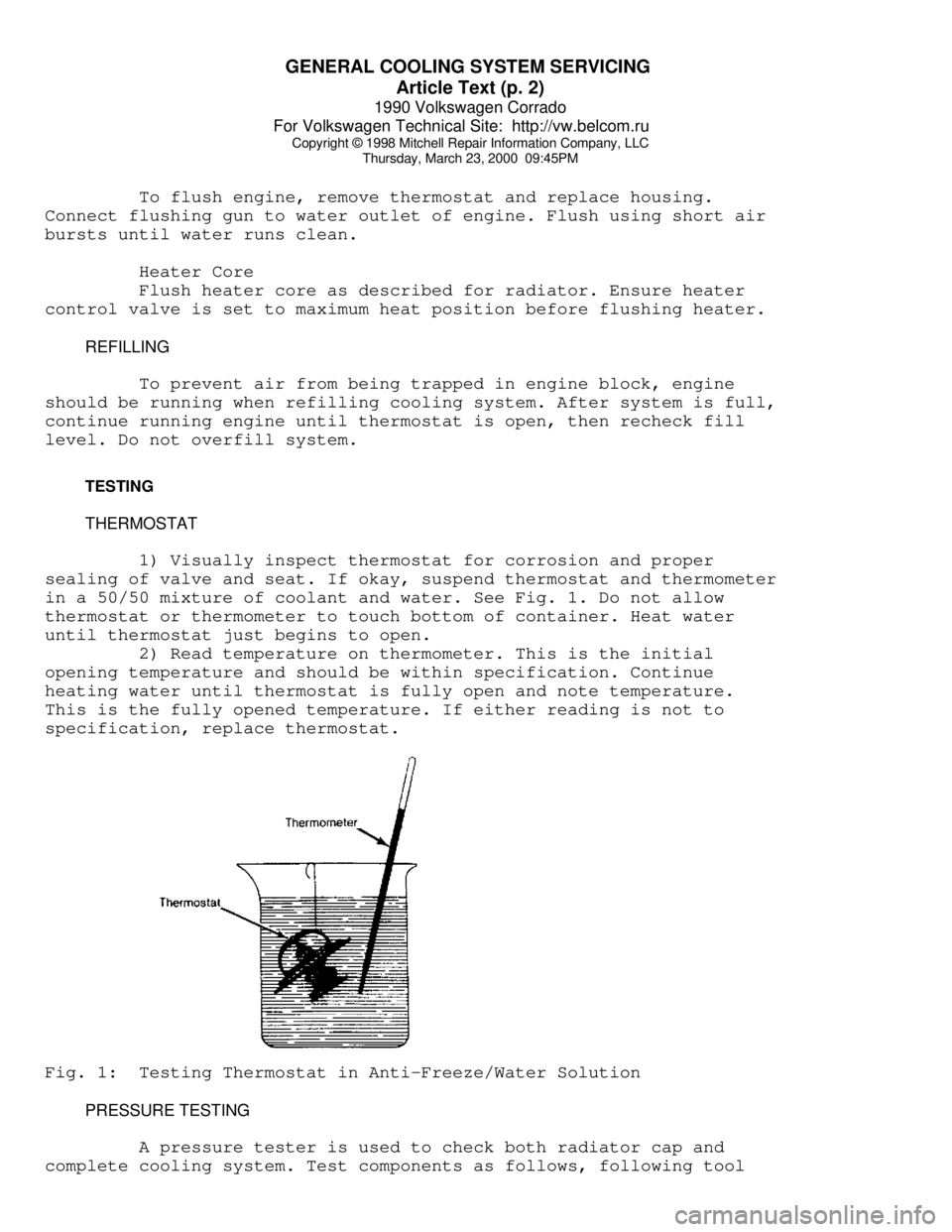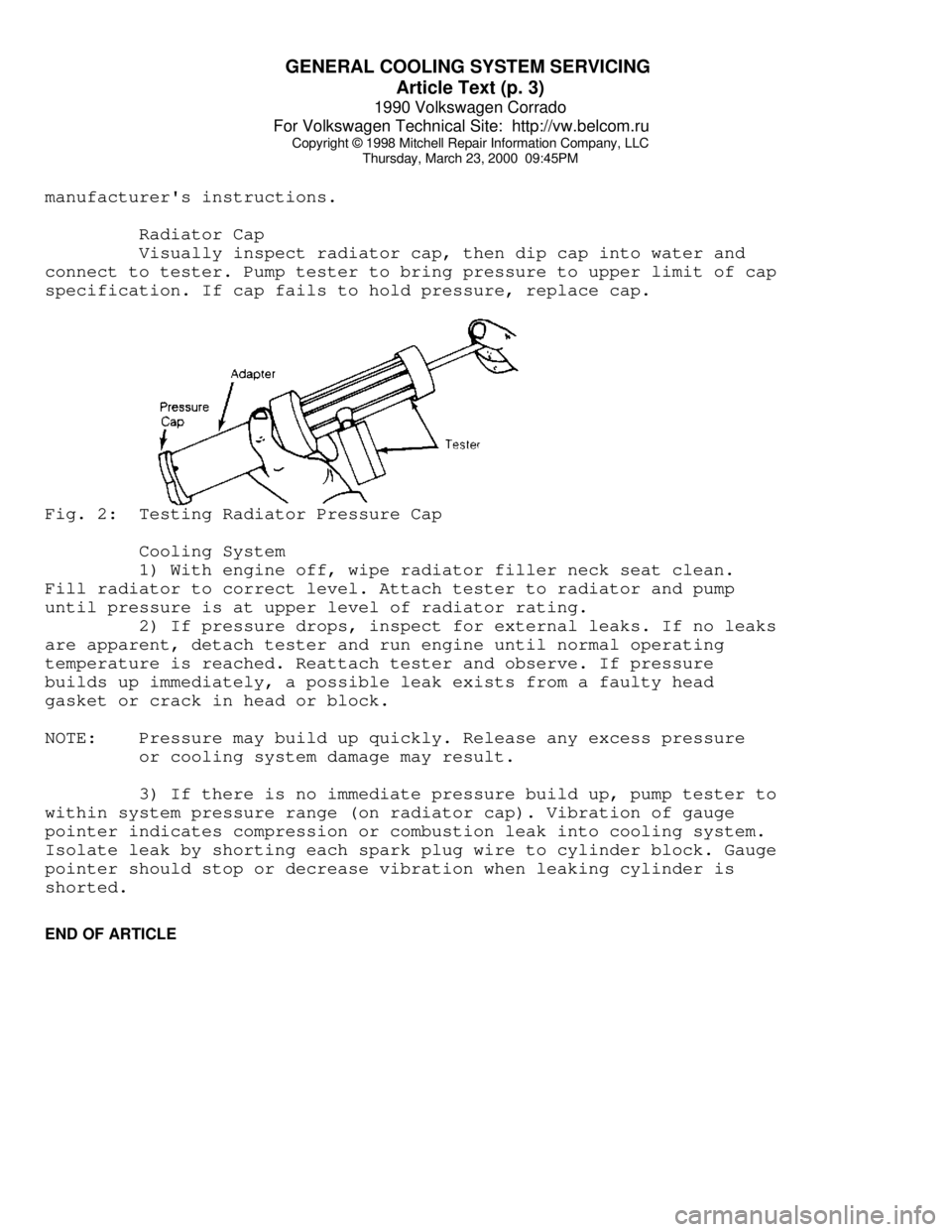1990 VOLKSWAGEN CORRADO engine
[x] Cancel search: enginePage 571 of 906

GENERAL COOLING SYSTEM SERVICING
Article Text
1990 Volkswagen Corrado
For Volkswagen Technical Site: http://vw.belcom.ru
Copyright © 1998 Mitchell Repair Information Company, LLC
Thursday, March 23, 2000 09:45PM
ARTICLE BEGINNING
GENERAL INFORMATION
General Cooling System Servicing
* PLEASE READ THIS FIRST *
The following article is for general information only.
Information may not apply to all years, makes and models. See specific
article in the ENGINE COOLING section.
DESCRIPTION
The basic liquid cooling system consists of a radiator, water
pump, thermostat, electric or belt-driven cooling fan, pressure cap,
heater, and various connecting hoses and cooling passages in the block
and cylinder head.
MAINTENANCE
DRAINING
Remove radiator cap and open heater control valve to maximum
heat position. Open drain cocks or remove plugs in bottom of radiator
and engine block. In-line engines usually have one plug or drain cock,
while "V" type engines will have 2, one in each bank of cylinders.
CLEANING
A good cleaning compound removes most rust and scale. Follow
manufacturer's instructions in the use of cleaner. If considerable
rust and scale has to be removed, cooling system should be flushed.
Clean radiator air passages with compressed air.
FLUSHING
CAUTION: Some manufacturers use an aluminum and plastic radiator.
Flushing solution must be compatible with aluminum.
Back Flushing
Back flushing is an effective means of removing cooling
system rust and scale. The radiator, engine and heater core should be
flushed separately.
Radiator
To flush radiator, connect flushing gun to water outlet of
radiator and disconnect water inlet hose. To prevent flooding engine,
use a hose connected to radiator inlet. Use air in short bursts to
prevent damage to radiator. Continue flushing until water runs clear.
Engine
Page 572 of 906

GENERAL COOLING SYSTEM SERVICING
Article Text (p. 2)
1990 Volkswagen Corrado
For Volkswagen Technical Site: http://vw.belcom.ru
Copyright © 1998 Mitchell Repair Information Company, LLC
Thursday, March 23, 2000 09:45PM
To flush engine, remove thermostat and replace housing.
Connect flushing gun to water outlet of engine. Flush using short air
bursts until water runs clean.
Heater Core
Flush heater core as described for radiator. Ensure heater
control valve is set to maximum heat position before flushing heater.
REFILLING
To prevent air from being trapped in engine block, engine
should be running when refilling cooling system. After system is full,
continue running engine until thermostat is open, then recheck fill
level. Do not overfill system.
TESTING
THERMOSTAT
1) Visually inspect thermostat for corrosion and proper
sealing of valve and seat. If okay, suspend thermostat and thermometer
in a 50/50 mixture of coolant and water. See Fig. 1. Do not allow
thermostat or thermometer to touch bottom of container. Heat water
until thermostat just begins to open.
2) Read temperature on thermometer. This is the initial
opening temperature and should be within specification. Continue
heating water until thermostat is fully open and note temperature.
This is the fully opened temperature. If either reading is not to
specification, replace thermostat.Fig. 1: Testing Thermostat in Anti-Freeze/Water Solution
PRESSURE TESTING
A pressure tester is used to check both radiator cap and
complete cooling system. Test components as follows, following tool
Page 573 of 906

GENERAL COOLING SYSTEM SERVICING
Article Text (p. 3)
1990 Volkswagen Corrado
For Volkswagen Technical Site: http://vw.belcom.ru
Copyright © 1998 Mitchell Repair Information Company, LLC
Thursday, March 23, 2000 09:45PM
manufacturer's instructions.
Radiator Cap
Visually inspect radiator cap, then dip cap into water and
connect to tester. Pump tester to bring pressure to upper limit of cap
specification. If cap fails to hold pressure, replace cap.Fig. 2: Testing Radiator Pressure Cap
Cooling System
1) With engine off, wipe radiator filler neck seat clean.
Fill radiator to correct level. Attach tester to radiator and pump
until pressure is at upper level of radiator rating.
2) If pressure drops, inspect for external leaks. If no leaks
are apparent, detach tester and run engine until normal operating
temperature is reached. Reattach tester and observe. If pressure
builds up immediately, a possible leak exists from a faulty head
gasket or crack in head or block.
NOTE: Pressure may build up quickly. Release any excess pressure
or cooling system damage may result.
3) If there is no immediate pressure build up, pump tester to
within system pressure range (on radiator cap). Vibration of gauge
pointer indicates compression or combustion leak into cooling system.
Isolate leak by shorting each spark plug wire to cylinder block. Gauge
pointer should stop or decrease vibration when leaking cylinder is
shorted.
END OF ARTICLE
Page 574 of 906

H - TESTS W/O CODES
Article Text
1990 Volkswagen Corrado
For Volkswagen Technical Site: http://vw.belcom.ru
Copyright © 1998 Mitchell Repair Information Company, LLC
Thursday, March 23, 2000 09:45PM
ARTICLE BEGINNING
1990 ENGINE PERFORMANCE
Trouble Shooting - No Codes
Volkswagen; Cabriolet, Corrado, Fox, Golf GL/GTI,
Jetta, Vanagon
INTRODUCTION
Before diagnosing symptoms or intermittent faults, perform
steps in F - BASIC TESTING article. Use this article to diagnose
driveability problems existing when a hard fault code is not present
or vehicle is not equipped with a self-diagnostic system.
NOTE: Some driveability problems may have been corrected by
manufacturer with a revised computer calibration chip or
computer control unit. Check with manufacturer for latest
chip or computer application.
Symptom checks can direct the technician to malfunctioning
component(s) for further diagnosis. A symptom should lead to a
specific component, system test or an adjustment.
Use intermittent test procedures to locate driveability
problems that DO NOT occur when the vehicle is being tested. These
test procedures should also be used if a soft (intermittent) trouble
code was present, but no problem was found during self-diagnostic
testing.
NOTE: For specific testing procedures, see I - SYSTEM/COMP
TESTS article. For specifications, see D - ADJUSTMENTS
or C - SPECIFICATIONS articles.
SYMPTOM DIAGNOSIS
Symptom checks cannot be used properly unless the problem is
actually happening while the vehicle is being tested. To reduce
diagnostic time, ensure steps in F - BASIC TESTING article have been
performed before attempting to diagnose a symptom. Symptoms available
for diagnosis include the following:
* Will Not Start or Starts Hard Cold (Cranks Okay)
* Will Not Start or Starts Hard Hot (Cranks Okay)
* Engine Stalls or Idles Rough
* Engine Misfires or Hesitates
* Excessive Fast Idle
* Engine Hesitates On Acceleration
* Engine Lacks Power
* Poor Fuel Mileage
* Engine Diesels
* Failed Emissions Test
Page 575 of 906

H - TESTS W/O CODES
Article Text (p. 2)
1990 Volkswagen Corrado
For Volkswagen Technical Site: http://vw.belcom.ru
Copyright © 1998 Mitchell Repair Information Company, LLC
Thursday, March 23, 2000 09:45PM
WILL NOT START OR STARTS HARD COLD (CRANKS OKAY)
* Check ignition fuse (if equipped).
* Check fuel pump fuse and fuel pump relay.
* Verify air intake system is unrestricted.
* Ensure fuel system pressure and volume are correct.
* Check cold start valve and thermo time switch operation.
* Ensure airflow sensor plate is in rest position. Adjust as
necessary.
* Test coolant temperature sensor and wiring. Repair or replace
as required.
* Check for poor ignition ground (1.8L & 2.0L 16-valve engines).
* Check for poor quality or contaminated fuel.
* Check condensation (water) in fuel tank causing fuel pump to
freeze (cold climate).
* Check exhaust system for restriction.
* Test airflow meter. Replace if faulty.
* Ensure sufficient secondary spark is available.
* Check air induction system for cracks or restriction.
* Ensure vacuum hoses are not disconnected or damaged.
* Ensure fuel system residual pressure is correct.
* Ensure fuel injector operation is correct.
* Ensure EGR valve operation is correct and valve closes
completely (if equipped).
* Check for cracks or poor connections at throttle body.
* Ensure ignition and valve timing are correct.
* Check ignition coil primary connections and wiring harness.
* Ensure ignition coil resistance is within specification.
* Check air temperature sensor operation (if equipped).
* Ensure electrical harness and connectors are not broken or loose.
* Ensure ECU or ignition control unit has correct voltage supply
and is properly grounded.
* Ensure engine has sufficient compression.
* Inspect intake air components for leaking hoses, connections or
cracks. Repair as required.
WILL NOT START OR STARTS HARD HOT (CRANKS OKAY)
* Check ignition fuse (if equipped).
* Check fuel system fuse and fuel pump relay.
* Check for poor quality or contaminated fuel.
* Check condensation (water) in fuel tank causing fuel pump to
freeze (cold climate).
* Check exhaust system for restriction.
* Check cold start valve and thermo time switch operation.
* Check fuel system and control system pressure. Replace pressure
regulator if necessary.
* Check residual fuel pressure. Replace fuel pump check valve or
fuel accumulator as necessary.
* Check oxygen sensor system operation.
* Ensure airflow sensor plate is in rest position. Adjust as
Page 576 of 906

H - TESTS W/O CODES
Article Text (p. 3)
1990 Volkswagen Corrado
For Volkswagen Technical Site: http://vw.belcom.ru
Copyright © 1998 Mitchell Repair Information Company, LLC
Thursday, March 23, 2000 09:45PM
necessary.
* Ensure injector spray patterns and volume are correct. Replace
faulty injectors.
* Inspect fuel lines and connections for leaks.
* Check carbon canister solenoid valves (CIS-E Motronic).
* Test airflow meter. Replace if faulty.
* Ensure sufficient secondary spark is available.
* Check air induction system for cracks or restriction.
* Check airflow sensor plate rest position.
* Ensure vacuum hoses are not disconnected or damaged.
* Ensure EGR valve operation is correct and valve closes
completely (if equipped).
* Check for cracks or poor connections at throttle body.
* Ensure ignition and valve timing are correct.
* Check ignition coil primary connections and wiring harness.
* Ensure ignition coil resistance is within specification.
* Check air temperature sensor operation.
* Check coolant temperature sensor operation.
* Ensure electrical harness and connectors are not broken or loose.
* Ensure ECU or ignition control unit has correct voltage supply
and is properly grounded.
* Ensure engine has sufficient compression.
ENGINE STALLS OR IDLES ROUGH
* Check fuel system and control system pressure. Replace pressure
regulator if necessary.
* Check cold start valve for leaking (engine warm).
* Ensure injector spray patterns and volume are correct. Replace
faulty injectors.
* Test coolant temperature sensor and wiring. Repair or replace
as required.
* Inspect intake air components for leaking hoses, connections or
cracks. Repair as required.
* Ensure airflow sensor plate movement and rest position. Adjust
as necessary.
* Test idle switch and idle air stabilizer valve.
* Perform system electrical checks.
* Check airflow meter. Replace if faulty.
* Ensure idle RPM is correct.
* Check auxiliary air by-pass regulator.
* Check fuel injector electrical connections.
* Use stethoscope to verify fuel injectors are operating.
* Ensure sufficient secondary spark is available in all cylinders.
* Verify vacuum hose routing is correct and there are no
vacuum leaks.
* Check idle stabilizer operation.
* Check for EGR system malfunction (if equipped).
* Check O2 sensor operation.
* Check for distortion or cracks in fuel injector(s) plastic
connecting flange(s).
* Check for use of poor quality fuel containing insufficient
Page 577 of 906

H - TESTS W/O CODES
Article Text (p. 4)
1990 Volkswagen Corrado
For Volkswagen Technical Site: http://vw.belcom.ru
Copyright © 1998 Mitchell Repair Information Company, LLC
Thursday, March 23, 2000 09:45PM
cleaning additives. Prolonged use of poor quality fuel can
cause injector clogging and carbon build-up on intake system.
ENGINE MISFIRES OR HESITATES
CIS-E & CIS-E MOTRONIC
* Ensure injector spray patterns and volume are correct. Replace
faulty injectors.
* Check fuel system and control system pressure. Replace pressure
regulator if necessary.
* Check Oxygen (O2) sensor system operation.
* Check fuel lines and connections for leaks.
* Test coolant temperature sensor and wiring. Repair or replace
as required.
* Check airflow meter and throttle switch. Replace if faulty.
* Ensure vacuum hoses are not disconnected or damaged.
* Ensure electrical harness connectors and wires are not
broken or loose.
* Check cold start valve for leaking (engine warm).
DIGIFANT II
* Check airflow sensor flap and sensor resistance. Replace
if faulty.
* Inspect intake air components for leaking hoses, connections
or cracks. Repair as required.
* Test intake air preheating system. Replace faulty components
as required.
* Check fuel system and control system pressure. Replace pressure
regulator if necessary.
* Ensure vacuum hoses are not disconnected or damaged.
* Ensure electrical harness connectors and wires are not
broken or loose.
* Check cold start valve for leaking (engine warm).
* Check coolant temperature sensor operation.
* Check Oxygen (O2) sensor voltage output.
EXCESSIVE FAST IDLE
* Inspect accelerator pedal and cable for worn parts or binding.
* Test idle switch (if equipped).
* Test auxiliary air regulator and replace if necessary
(if equipped).
* Inspect throttle valve and adjust or replace as required.
* Check carbon canister solenoid valves (CIS-E Motronic).
* Test idle boost valve system operation (1.8L 8-valve engine
only). Replace faulty parts as necessary.
* Test coolant temperature sensor and wiring (Digifant II). Repair
or replace as required.
* Check throttle cable adjustment.
* Verify vacuum hose routing is correct.
Page 578 of 906

H - TESTS W/O CODES
Article Text (p. 5)
1990 Volkswagen Corrado
For Volkswagen Technical Site: http://vw.belcom.ru
Copyright © 1998 Mitchell Repair Information Company, LLC
Thursday, March 23, 2000 09:45PM
* Ensure there are no vacuum leaks.
* Check idle stabilizer operation (if equipped).
* Ensure fuel system pressure and volume are correct.
* Check auxiliary air by-pass regulator.
* Check cold start valve for leaking (engine warm).
ENGINE HESITATES ON ACCELERATION
* Inspect intake air components for leaking hoses
* Check injector spray pattern. Check for faulty injectors.
* Check cold start valve for leaking (engine warm).
* Check airflow sensor plate movement. Replace fuel distributor
as necessary.
* Check airflow sensor plate position. Adjust as necessary.
* Check fuel system and control system pressure. Replace pressure
regulator if necessary.
* Test airflow sensor plate potentiometer. Adjust or replace
as necessary.
* Perform system electrical checks.
* Check idle mixture CO adjustment. Adjust as necessary.
ENGINE LACKS POWER
* Test coolant temperature sensor and wiring. Repair or
replace as required.
* Check fuel system and control system pressure. Replace pressure
regulator if necessary.
* Check throttle cable adjustment.
* Check throttle switch. Adjust or replace as necessary.
* Check airflow sensor screen for damage or incorrect installation
(if equipped).
* Check ignition timing and knock sensor control (if equipped).
Adjust as necessary.
* Check EGR system for correct operation (if equipped).
* Ensure base timing is correct and timing advance system
is functional.
* Check transmission for correct downshift (auto. trans.)
* Check fuel tank filler tube for tampering of restrictor. If
tampering has occurred, check catalytic converter for lead
contamination and exhaust system restriction.
* Check for use of poor quality fuel containing insufficient
cleaning additives. Prolonged use of poor quality fuel can
cause injector clogging and carbon build-up on intake system.
* Inspect intake air element, housing, and preheating system.
* Check airflow sensor plate movement. Replace if necessary.
POOR FUEL MILEAGE
* Ensure idle speed, base timing and timing advance are
set to specifications.
* Check cold start valve for leaking (engine warm).